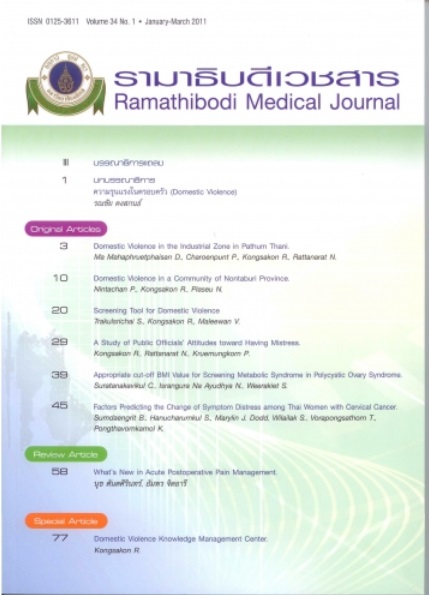What's New in Acute Postoperative Pain Management
Main Article Content
Abstract
Acute postoperative pain คือลักษณะอาการปวดที่เกิดจากแผลผ่าตัดหรือเกี่ยวเนื่องกับการผ่าตัด
กลไกลของความเจ็บปวด (Pain Pathways) การผ่าตัดทำให้เกิดการบาดเจ็บของเนื้อเยื่อและมีการหลั่งสารกระตุ้นทำให้เกิดความปวด (noxious stimuli) เช่นprostaglandins, histamine, serotonin, bradykinin และ substance P ตัวรับสัญญาณ ว่ามีการบาดเจ็บต่อเนื้อเยื่อ (nociceptor) จะแปลงสัญญาณนี้ส่งต่อไปทางใยประสาท A delta และ C ถึงไขสันหลัง ไขสันหลังจะมีการเปลี่ยนแปลงสัญญาณต่างๆ ได้มากมาย สัญญาณบางส่วนจะส่งผ่านไปทาง ventral และ ventrolateral horn ทำให้เกิดการตอบสนองแบบ segmental reflex และสัญญาณส่วนอื่นๆ นั้น จะส่งผ่านไปทาง spinothallamic และ spinoreticular tract ทำให้เกิดการตอบสนองในระดับ suprasegmental และ cortex ออกมา
การตอบสนองต่อการผ่าตัดแบบ segmental reflex ได้แก่ การหดเกร็งตัวของกล้ามเนื้อทำให้มีการใช้ออกซิเจนมากขึ้น และมีการสร้งกรดแลคติด การกระตุ้นเซลล์ประสาท sympathetic กำให้หัวใจเต้นเร็ว เพิ่ม stroke volume หัวใจทำงานหนักมากขึ้น และกล้ามเนื้อหัวใจต้องใช้ออกซิเจนมากขึ้น กล้ามเนื้อในระบบทางเดินอาหารและทางเดินปัสสาวะเกิดการหย่อนตัว และยับยั้งการทำงานของเส้นประสาท Phrenic การตอบสนองแบบ segmental reflex ทำให้ sympathetic tone เพิ่มมากขึ้นเละกระตุ้น hypothalamus ทำให้เมตาบอลิซึมละการใช้ออกชิเจนมากยิ่งขึ้นอีก
ผู้ป่วยหลังผ่าตัดจะมีการตอบสนองที่ระดับ cortex โดย ถูกกระตุ้นด้วยสัญญาณที่ส่งความปวดไปถึงศูนย์ต่างๆ ใน สมอง ซึ่งจะประมวลผลจากสัญญาณและรับรู้ความเจ็บปวดการกระตุ้นในระดับ Hypothalamนs จะทำให้เกิดความกลัวความกังวลร่วมกับความเจ็บปวด
Article Details
References
Kissin I. Preemptive analgesia. Anesthesiology. 2000;93(4):1138-43. doi:10.1097/00000542-200010000-00040.
Ong CK, Lirk P, Seymour RA, Jenkins BJ. The efficacy of preemptive analgesia for acute postoperative pain management: a meta-analysis. Anesth Analg.2005;100(3):757-73. doi:10.1213/01.ANE.0000144428.98767.0E.
Viscusi ER, Reynolds L, Chung F, Atkinson LE, Khanna S. Patient-controlled transdermal fentanyl hydrochloride vs intravenous morphine pump for postoperative pain: a randomized controlled trial. JAMA. 2004;291(11):1333-41. doi:10.1001/jama.291.11.1333.
Edwards JE, McQuay HJ, Moore RA. Combination analgesic efficacy: Individual patient data meta-analysis of single-dose oral tramadol plus acetaminophen in acute postoperative pain. J Pain Symptom Manage. 2002;23(2):121-30. doi:10.1016/s0885-3924(01)00404-3.
Sinatra RS, Jahr JS, Reynoids LW, Viscusi ER, Groudine SB, Payen-Champenois C. Efficacy and safety of single and repeated administration of 1 gram intravenous acetaminophen injection (paracetamol) for pain management after major orthopedic surgery. Anesthesiology. 2005;102(4):822-31. doi:10.1097/00000542-200504000-00019.
Miller H, Minkowitz HS, Wininger SJ, Royal MA. Poster Presentation- A phase IIl, multi-center, randomized, double-blind, placebo-controlled 24 hour study of the efficacy and safety of intravenous acetaminophen in abdominal laparoscopic surgery, Proceeding and Abstracts 34th Annual Regional Anesthesia Meeting and Workshops, Phoenix, AZ. Aprill 30 - May 3, 2009.
Amar PJ, Schiff ER. Acetaminophen safety and hepatotoxic--where do we go from here? Expert Opin Drug Saf. 2007:6(4):341-55. doi:10.1517/14740338.6.4.341.
Lee A, Cooper MG, Craig JC, Knight JF, Keneally JP. Effects of nonsteroidal anti-inflammatory drugs on postoperative renal function in adults with normal renal function. Cochrane Database Syst Rev. 2007;(2):CD002765. doi:10.1002/14651858.CD002765.pub3.
Nussmeier NA, Whelton AA, Brown MT, Langford RM, Hoeft A, Parlow JL, et al. Complications of the COX-2 inhibitors parecoxib and valdecoxib after cardiac surgery. N Engl J Med. 2005;352(11):1081-91. doi:10.1056/NEJMoa050330.
Moodie JE, Brown CR, Bisley EJ, Weber HU, Bynum L. The safety and analgesic efficacy of intranasal ketorolac in patients with postoperative pain. Anesth Analg. 2008;107(6):2025-31. doi:10.1213/ane.0b013e318188b736.
Southworth S, Peters J, Rock A, Pavliv L. A multicenter, randomized, double-blind, placebocontrolled trial of intravenous ibuprofen 400 and 800 mg every 6 hours in the management of postoperative pain. Clin Ther. 2009 ;31(9):1922-35. doi:10.1016/j.clinthera.2009.08.026.
Célèrier E, Rivat C, Jun Y, Laulin JP, Larcher A, Reynier P, et al. Long-lasting hyperalgesia induced by fentanyl in rats: preventive effect of ketamine. Anesthesiology. 2000;92(2):465-72. doi:10.1097/00000542-200002000-00029.
Bell RF, Dahl JB, Moore RA, Kalso E. Perioperative ketamine for acute postoperative pain. Cochrane Database Syst Rev. 2006;(1):CD004603. doi:10.1002/14651858.CD004603.pub2.
Christensen K, Rogers E, Green GA, Hamilton DA, Mermelstein F, Liao E, et al. Safety and efficacy of intranasal ketamine for acute postoperative pain. Acute Pain. 2007;9(4):183-192. doi:10.1016/j.acpain.2007.09.001.
Block BM, Liu SS, Rowlingson AJ, Cowan AR, Cowan JA, Wu CL. Efficacy of postoperative epidural analgesia: a meta-analysis. JAMA 2003;290(18):2455-63. doi:10.1001/jama.290.18.2455.
Liu S, Carpenter RL, Neal JM. Epidural anesthesia and analgesia. Their role in postoperative outcome. Anesthesiology. 1995;82(6):1474-506. doi:10.1097/00000542-199506000-00019.
van der Vyver M, Halpern S, Joseph G. Patient-controlled epidural analgesia versus continuous infusion for labour analgesia: a meta-analysis. Br J Anaesth. 2002;89(3):459-65. doi:10.1093/bja/aef217.
Wu CL, Fleisher LA. Outcomes research in regional anesthesia and analgesia. Anesth Analg. 2000;91(5):1232-42. doi:10.1097/00000539-200011000-00035.
Rodgers A, Walker N, Schug S, Mckee A, Kehlet H, van Zundert A, et al. Reduction of postoperative mortality and morbidity with epidural or spinal anaesthesia: results from overview of randomised trials. BMJ. 2000;321(7275):1493. doi:10.1136/bmj.321.7275.1493.
Ballantyne JC, Carr DB, deFerranti S, Suarez T, Lau J, Chalmers TC. The comparative effects of postoperative analgesic therapies on pulmonary outcome: cumulative meta-analyses of randomized, controlled trials. Anesth Analg. 1998:86(3):598-612. doi:10.1097/00000539-199803000-00032.
Keck S, Glennon C, Ginsberg B. DepoDur extended-release epidural morphine: reshaping postoperative care: what perioperative nurses need to know. Orthop Nurs. 2007;26(2):86-93; quiz 94-5. doi:10.1097/01.NOR.0000265863.78103.78.
American Society of Anesthesiologists Task Force on Neuraxial Opioids, Horlocker TT, Burton AW, Connis RT, Hughes SC, Nickinovich DG, et al. Practice guidelines for the prevention, detection, and management of respiratory depression associated with neuraxial opioid administration. Anesthesiology 2009;110(2):218-30. doi:10.1097/ALN.0b013e31818ec946.
Rathmell JP, Lair TR, Nauman B.The role of intrathecal drugs in the treatment of acute pain. Anesth Analg. 2005;101(5 Suppl):S30-43. doi:10.1213/01.ane.0000177101.99398.22.
Liu SS, Salinas FV. Continuous plexus and peripheral nerve blocks for postoperative analgesia. Anesth Analg. 2003;96(1):263-72. doi:10.1097/00000539-200301000-00053.
Richman JM, Liu SS, Courpas G, Wong R, Rowlingson AJ, McGreadye J, et al. Does continuous peripheral nerve block provide superior pain control to opioids? A meta-analysis. Anesth Analg. 2006;102(1):248-57. doi:10.1213/01.ANE.0000181289.09675.7D.
Kalso E, Smith L, McQuay HJ, Moore RA. No pain, no gain: clinical excellence and scientific rigour--lessons learned from IA morphine. Pain. 2002;98(3):269-75. doi:10.1016/s0304-3959(02)00019-2.
Moiniche S, Mikkelsen S, Wetterslev J, Dahl JB. A systematic review of intra-articular local anesthesia for postoperative pain relief after arthroscopic knee surgery. Reg Anesth Pain Med. 1999:24(5):430-7. doi:10.1016/s1098-7339(99)90010-x.
Kizilkaya M, Yildirim OS, Dogan N, Kursad H, Okur A. Analgesic Effects of Intraarticular Sufentanil and Sufentanil Plus Methylprednisolone After Arthroscopic Knee Surgery. Anesth Analg. 2004 Apr;98(4):1062-5. doi:10.1213/01.ane.0000103185.18333.68.
American Society of Anesthesiologists Task Force on Acute Pain Management. Practice guidelines for acute pain management in the perioperative setting: an updated report by the American Society of Anesthesiologists Task Force on Acute Pain Management. Anesthesiology. 2004;100(6):1573-81. doi:10.1097/00000542-200406000-00033.
Dolin SJ, Cashman JN, Bland JM. Effectiveness of acute postoperative pain management: I. Evidence from published data. Br J Anaesth. 2002;89(3):409-23.
White PF. The changing role of non-opioid analgesic techniques in the management of postoperative pain. Anesth Analg. 2005;101(5 Suppl):S5-22. doi:10.1213/01.ane.0000177099.28914.a7.
